Abstract
The aim of this study was to investigate whether antibody responses against synthetic peptides derived from genital human papillomavirus (HPV) proteins are associated with laboratory-proven genital and anorectal HPV infection. In this study, 158 heterosexual patients (110 women and 48 men) were followed prospectively. At each visit we collected serum samples as well as specimens from several sites in the anogenital area for detection of HPV type 6/11 (HPV-6/11), -16, -18, and -33 DNAs by PCR. Immunoglobulin A (IgA) and IgG responses against disrupted bovine papilloma virions and eight different synthetic peptides derived from HPV-6/11, -16, and -18 were determined for serum samples from the first and the last visits. The subjects attended the Municipal Sexually Transmitted Disease Clinic in Amsterdam, The Netherlands, two to seven times (mean, four times) at approximately 4-month intervals. Women were monitored over a period of 155 person-years, and men were monitored over 65 person-years. The magnitudes of the IgA responses against HPV-16 late protein epitopes L1:13, L1:31, and L2:49 were significantly higher in the sera from the last visit among the currently HPV DNA-positive participants than in HPV DNA-negative persons (P = 0.02). When the persons positive for any HPV type at any time during the follow-up period were compared with those who were negative at all times during the follow-up period, we also found a significant elevation of IgA responses against L1:31 and L2:49 (P = 0.04 and 0.01, respectively).(ABSTRACT TRUNCATED AT 250 WORDS)
Full text
PDF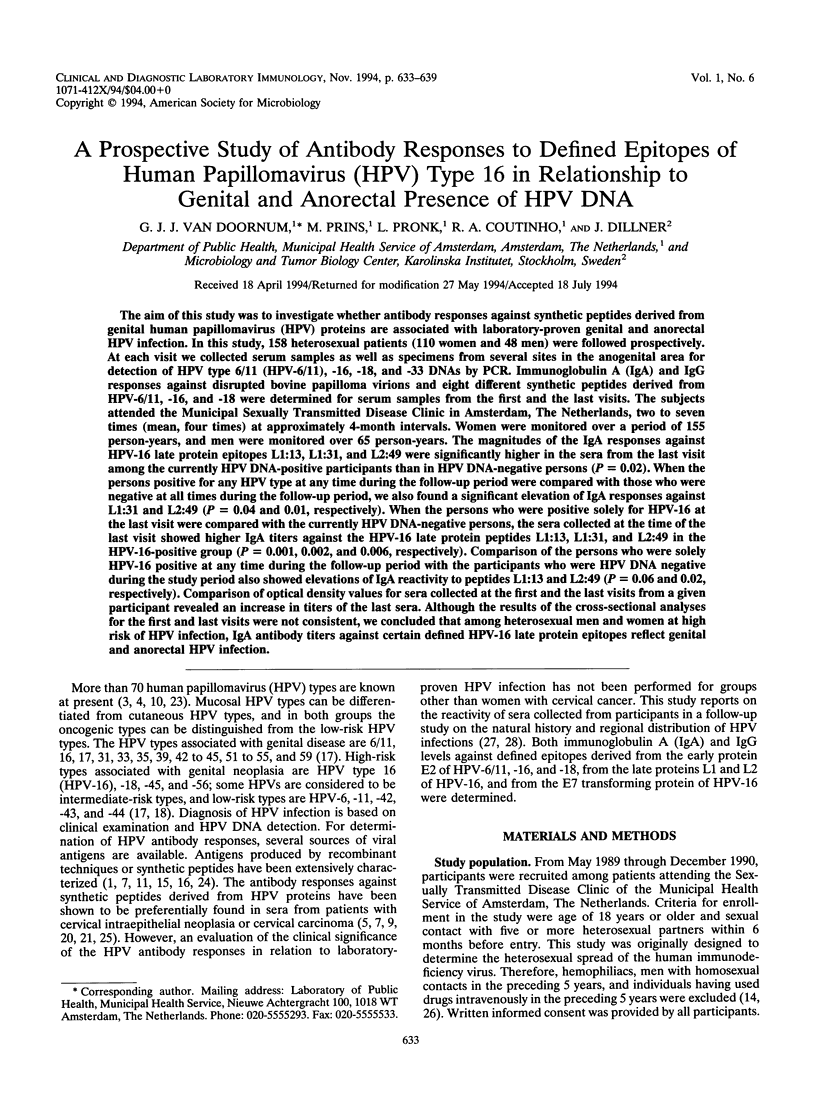
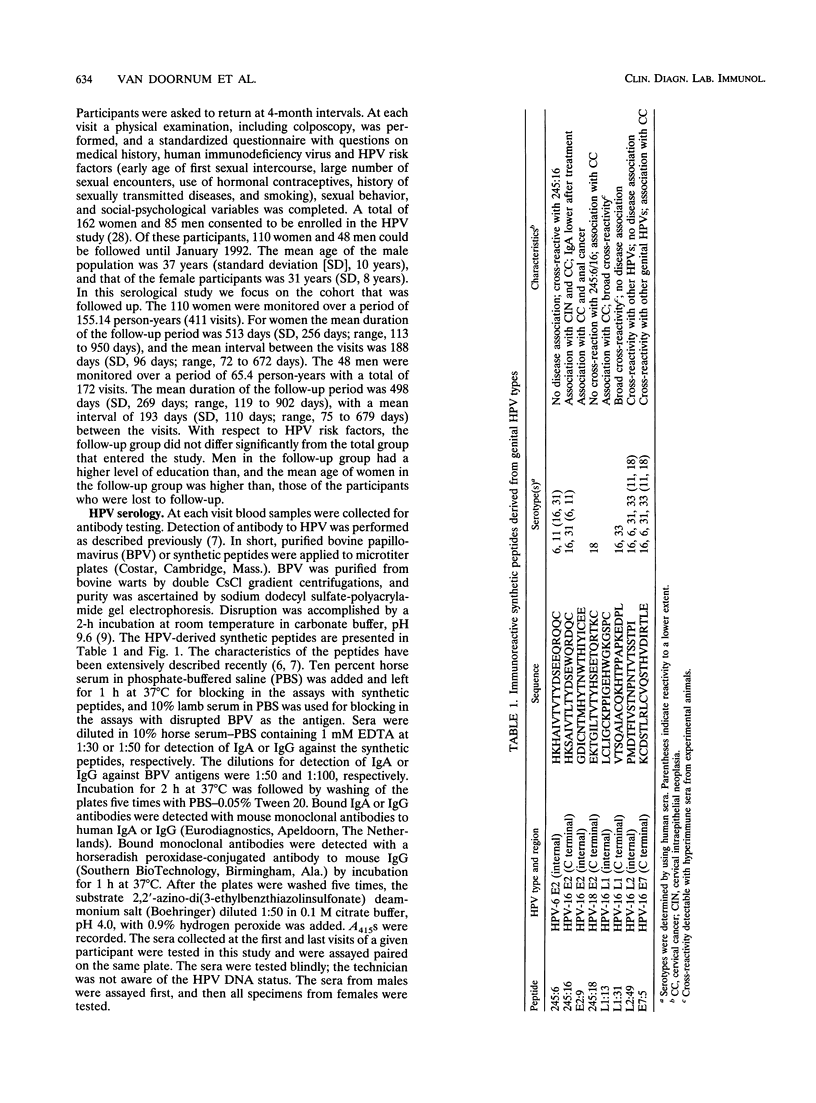
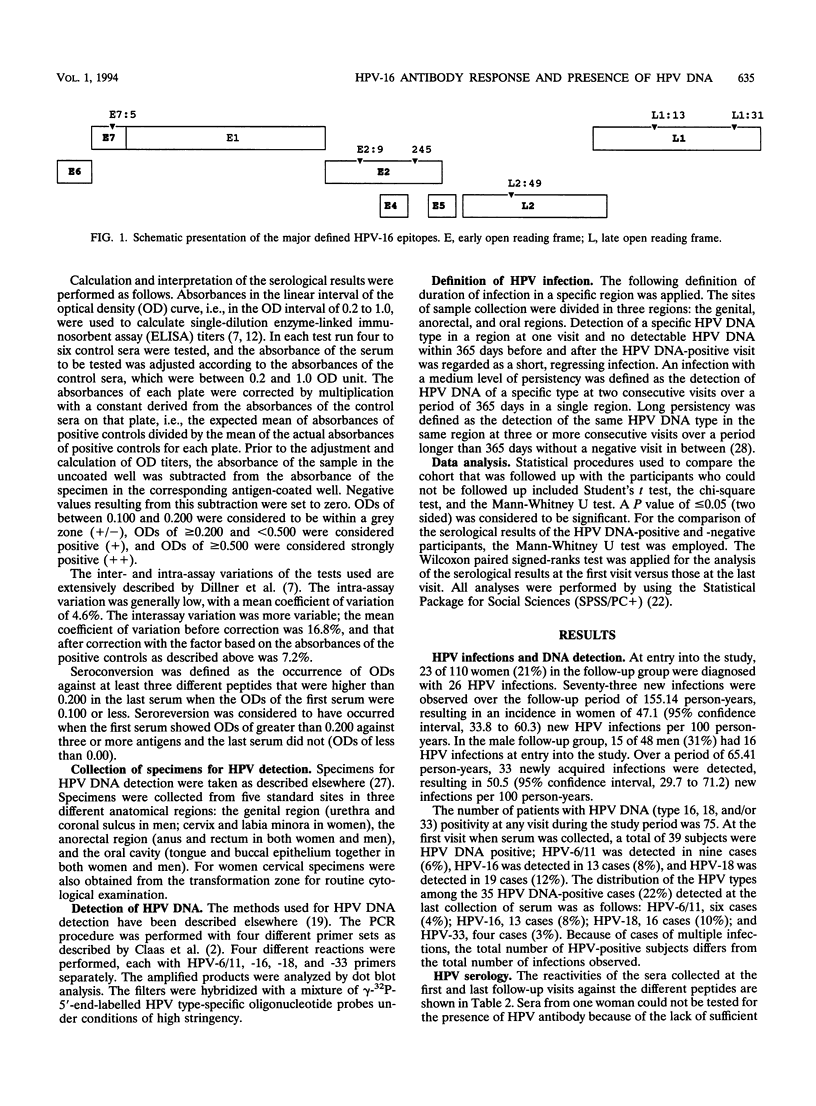
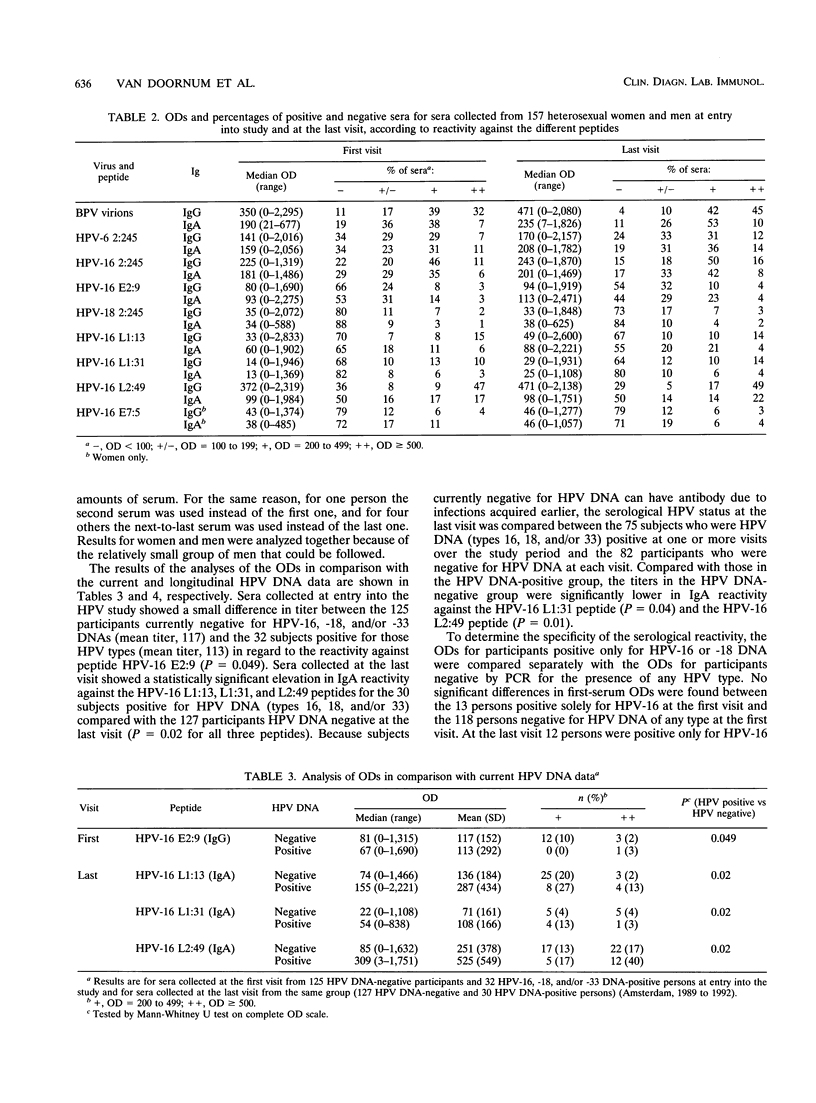
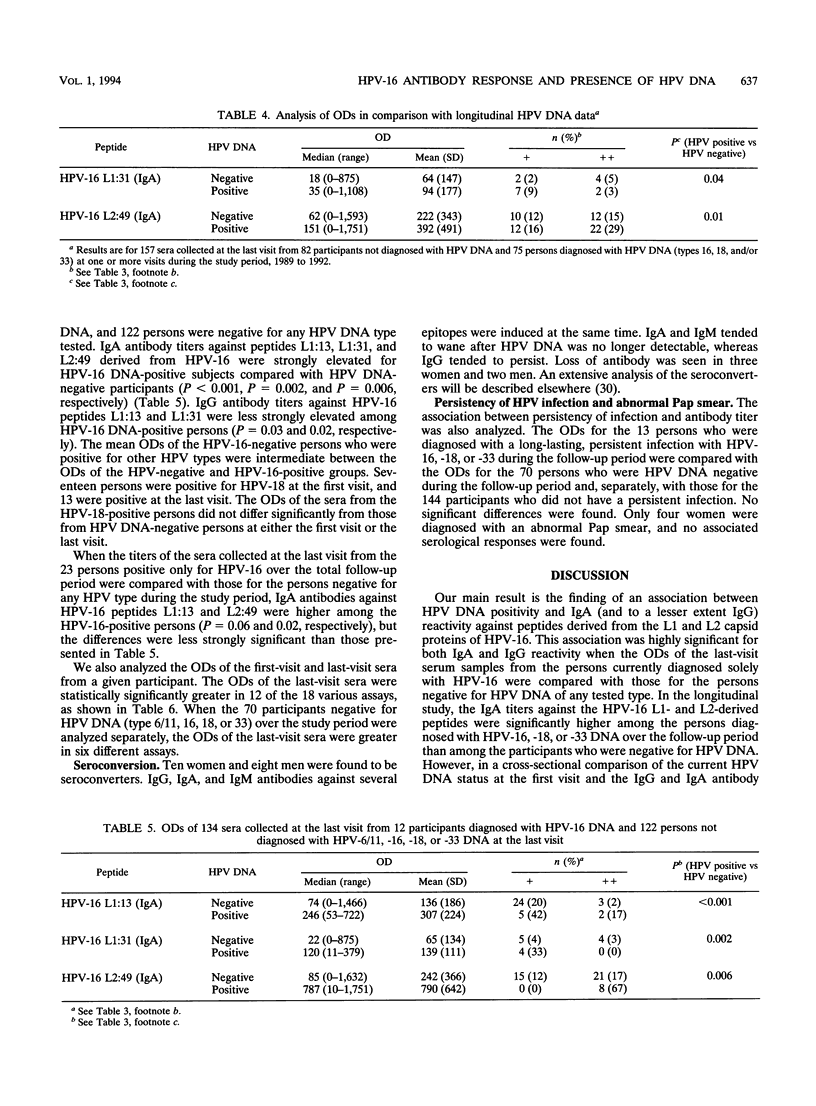
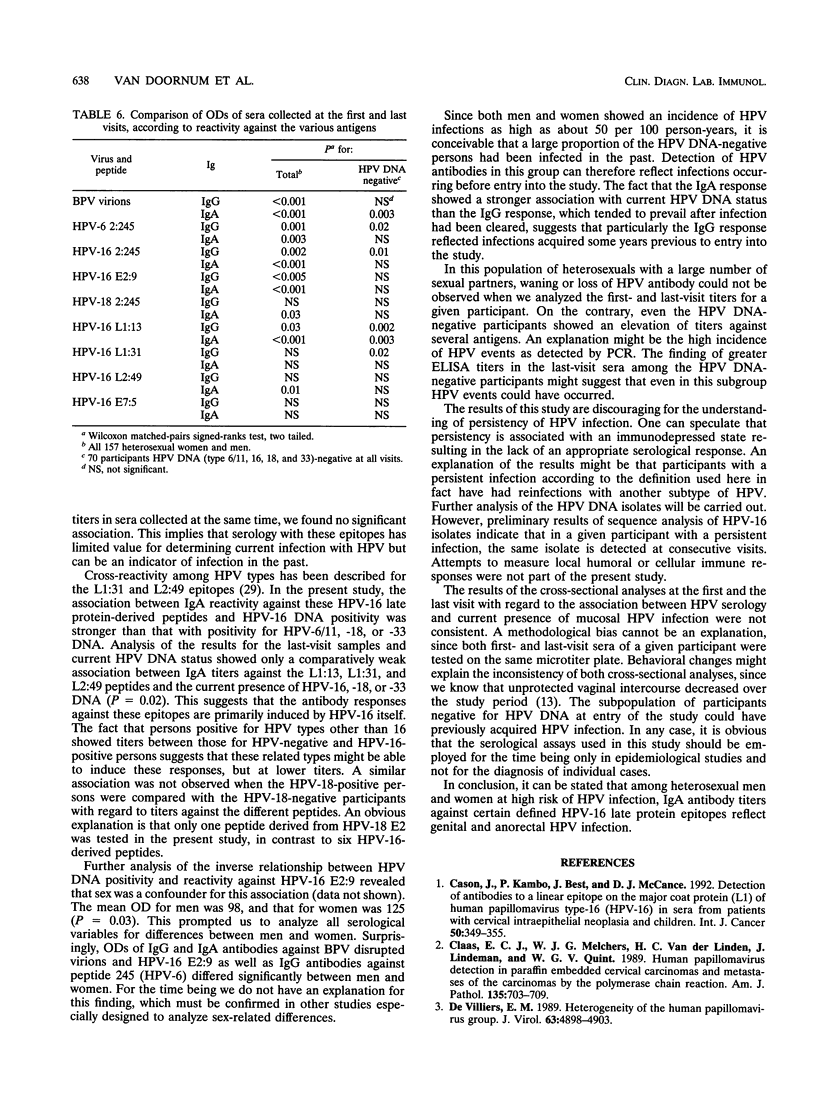
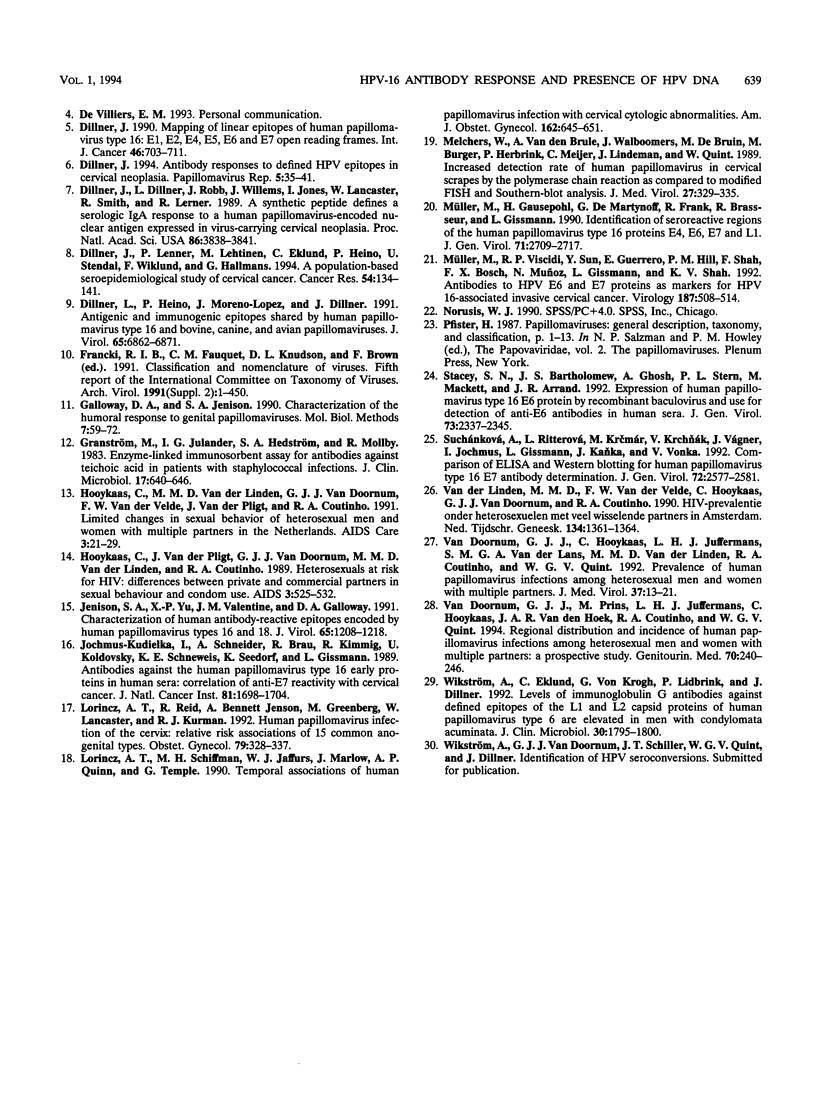
Selected References
These references are in PubMed. This may not be the complete list of references from this article.
- Cason J., Kambo P. K., Best J. M., McCance D. J. Detection of antibodies to a linear epitope on the major coat protein (L1) of human papillomavirus type-16 (HPV-16) in sera from patients with cervical intraepithelial neoplasia and children. Int J Cancer. 1992 Feb 1;50(3):349–355. doi: 10.1002/ijc.2910500304. [DOI] [PubMed] [Google Scholar]
- Claas E. C., Melchers W. J., van der Linden H. C., Lindeman J., Quint W. G. Human papillomavirus detection in paraffin-embedded cervical carcinomas and metastases of the carcinomas by the polymerase chain reaction. Am J Pathol. 1989 Oct;135(4):703–709. [PMC free article] [PubMed] [Google Scholar]
- Dillner J., Dillner L., Robb J., Willems J., Jones I., Lancaster W., Smith R., Lerner R. A synthetic peptide defines a serologic IgA response to a human papillomavirus-encoded nuclear antigen expressed in virus-carrying cervical neoplasia. Proc Natl Acad Sci U S A. 1989 May;86(10):3838–3841. doi: 10.1073/pnas.86.10.3838. [DOI] [PMC free article] [PubMed] [Google Scholar]
- Dillner J., Lenner P., Lehtinen M., Eklund C., Heino P., Wiklund F., Hallmans G., Stendahl U. A population-based seroepidemiological study of cervical cancer. Cancer Res. 1994 Jan 1;54(1):134–141. [PubMed] [Google Scholar]
- Dillner J. Mapping of linear epitopes of human papillomavirus type 16: the E1, E2, E4, E5, E6 and E7 open reading frames. Int J Cancer. 1990 Oct 15;46(4):703–711. doi: 10.1002/ijc.2910460426. [DOI] [PubMed] [Google Scholar]
- Dillner L., Heino P., Moreno-Lopez J., Dillner J. Antigenic and immunogenic epitopes shared by human papillomavirus type 16 and bovine, canine, and avian papillomaviruses. J Virol. 1991 Dec;65(12):6862–6871. doi: 10.1128/jvi.65.12.6862-6871.1991. [DOI] [PMC free article] [PubMed] [Google Scholar]
- Galloway D. A., Jenison S. A. Characterization of the humoral immune response to genital papillomaviruses. Mol Biol Med. 1990 Feb;7(1):59–72. [PubMed] [Google Scholar]
- Granström M., Julander I. G., Hedström S. A., Möllby R. Enzyme-linked immunosorbent assay for antibodies against teichoic acid in patients with staphylococcal infections. J Clin Microbiol. 1983 Apr;17(4):640–646. doi: 10.1128/jcm.17.4.640-646.1983. [DOI] [PMC free article] [PubMed] [Google Scholar]
- Hooykaas C., van der Linden M. M., van Doornum G. J., van der Velde F. W., van der Pligt J., Coutinho R. A. Limited changes in sexual behaviour of heterosexual men and women with multiple partners in The Netherlands. AIDS Care. 1991;3(1):21–30. doi: 10.1080/09540129108253044. [DOI] [PubMed] [Google Scholar]
- Hooykaas C., van der Pligt J., van Doornum G. J., van der Linden M. M., Coutinho R. A. Heterosexuals at risk for HIV: differences between private and commercial partners in sexual behaviour and condom use. AIDS. 1989 Aug;3(8):525–532. [PubMed] [Google Scholar]
- Jenison S. A., Yu X. P., Valentine J. M., Galloway D. A. Characterization of human antibody-reactive epitopes encoded by human papillomavirus types 16 and 18. J Virol. 1991 Mar;65(3):1208–1218. doi: 10.1128/jvi.65.3.1208-1218.1991. [DOI] [PMC free article] [PubMed] [Google Scholar]
- Jochmus-Kudielka I., Schneider A., Braun R., Kimmig R., Koldovsky U., Schneweis K. E., Seedorf K., Gissmann L. Antibodies against the human papillomavirus type 16 early proteins in human sera: correlation of anti-E7 reactivity with cervical cancer. J Natl Cancer Inst. 1989 Nov 15;81(22):1698–1704. doi: 10.1093/jnci/81.22.1698. [DOI] [PubMed] [Google Scholar]
- Lorincz A. T., Reid R., Jenson A. B., Greenberg M. D., Lancaster W., Kurman R. J. Human papillomavirus infection of the cervix: relative risk associations of 15 common anogenital types. Obstet Gynecol. 1992 Mar;79(3):328–337. doi: 10.1097/00006250-199203000-00002. [DOI] [PubMed] [Google Scholar]
- Lorincz A. T., Schiffman M. H., Jaffurs W. J., Marlow J., Quinn A. P., Temple G. F. Temporal associations of human papillomavirus infection with cervical cytologic abnormalities. Am J Obstet Gynecol. 1990 Mar;162(3):645–651. doi: 10.1016/0002-9378(90)90974-c. [DOI] [PubMed] [Google Scholar]
- Melchers W., van den Brule A., Walboomers J., de Bruin M., Burger M., Herbrink P., Meijer C., Lindeman J., Quint W. Increased detection rate of human papillomavirus in cervical scrapes by the polymerase chain reaction as compared to modified FISH and southern-blot analysis. J Med Virol. 1989 Apr;27(4):329–335. doi: 10.1002/jmv.1890270413. [DOI] [PubMed] [Google Scholar]
- Müller M., Gausepohl H., de Martynoff G., Frank R., Brasseur R., Gissmann L. Identification of seroreactive regions of the human papillomavirus type 16 protein E4, E6, E7 and L1. J Gen Virol. 1990 Nov;71(Pt 11):2709–2717. doi: 10.1099/0022-1317-71-11-2709. [DOI] [PubMed] [Google Scholar]
- Müller M., Viscidi R. P., Sun Y., Guerrero E., Hill P. M., Shah F., Bosch F. X., Muñoz N., Gissmann L., Shah K. V. Antibodies to HPV-16 E6 and E7 proteins as markers for HPV-16-associated invasive cervical cancer. Virology. 1992 Apr;187(2):508–514. doi: 10.1016/0042-6822(92)90453-v. [DOI] [PubMed] [Google Scholar]
- Stacey S. N., Bartholomew J. S., Ghosh A., Stern P. L., Mackett M., Arrand J. R. Expression of human papillomavirus type 16 E6 protein by recombinant baculovirus and use for detection of anti-E6 antibodies in human sera. J Gen Virol. 1992 Sep;73(Pt 9):2337–2345. doi: 10.1099/0022-1317-73-9-2337. [DOI] [PubMed] [Google Scholar]
- Suchánková A., Ritterová L., Krcmár M., Krchnák V., Vágner J., Jochmus I., Gissmann L., Kanka J., Vonka V. Comparison of ELISA and western blotting for human papillomavirus type 16 E7 antibody determination. J Gen Virol. 1991 Oct;72(Pt 10):2577–2581. doi: 10.1099/0022-1317-72-10-2577. [DOI] [PubMed] [Google Scholar]
- Van Doornum G. J., Prins M., Juffermans L. H., Hooykaas C., van den Hoek J. A., Coutinho R. A., Quint W. G. Regional distribution and incidence of human papillomavirus infections among heterosexual men and women with multiple sexual partners: a prospective study. Genitourin Med. 1994 Aug;70(4):240–246. doi: 10.1136/sti.70.4.240. [DOI] [PMC free article] [PubMed] [Google Scholar]
- Wikström A., Eklund C., Von Krogh G., Lidbrink P., Dillner J. Levels of immunoglobulin G antibodies against defined epitopes of the L1 and L2 capsid proteins of human papillomavirus type 6 are elevated in men with a history of condylomata acuminata. J Clin Microbiol. 1992 Jul;30(7):1795–1800. doi: 10.1128/jcm.30.7.1795-1800.1992. [DOI] [PMC free article] [PubMed] [Google Scholar]
- de Villiers E. M. Heterogeneity of the human papillomavirus group. J Virol. 1989 Nov;63(11):4898–4903. doi: 10.1128/jvi.63.11.4898-4903.1989. [DOI] [PMC free article] [PubMed] [Google Scholar]
- van Doornum G. J., Hooykaas C., Juffermans L. H., van der Lans S. M., van der Linden M. M., Coutinho R. A., Quint W. G. Prevalence of human papillomavirus infections among heterosexual men and women with multiple sexual partners. J Med Virol. 1992 May;37(1):13–21. doi: 10.1002/jmv.1890370104. [DOI] [PubMed] [Google Scholar]
- van der Linden M. M., van der Velde F. W., Hooykaas C., van Doornum G. J., Coutinho R. A. HIV-prevalentie onder heteroseksuelen met veel wisselende partners in Amsterdam. Ned Tijdschr Geneeskd. 1990 Jul 14;134(28):1361–1364. [PubMed] [Google Scholar]


